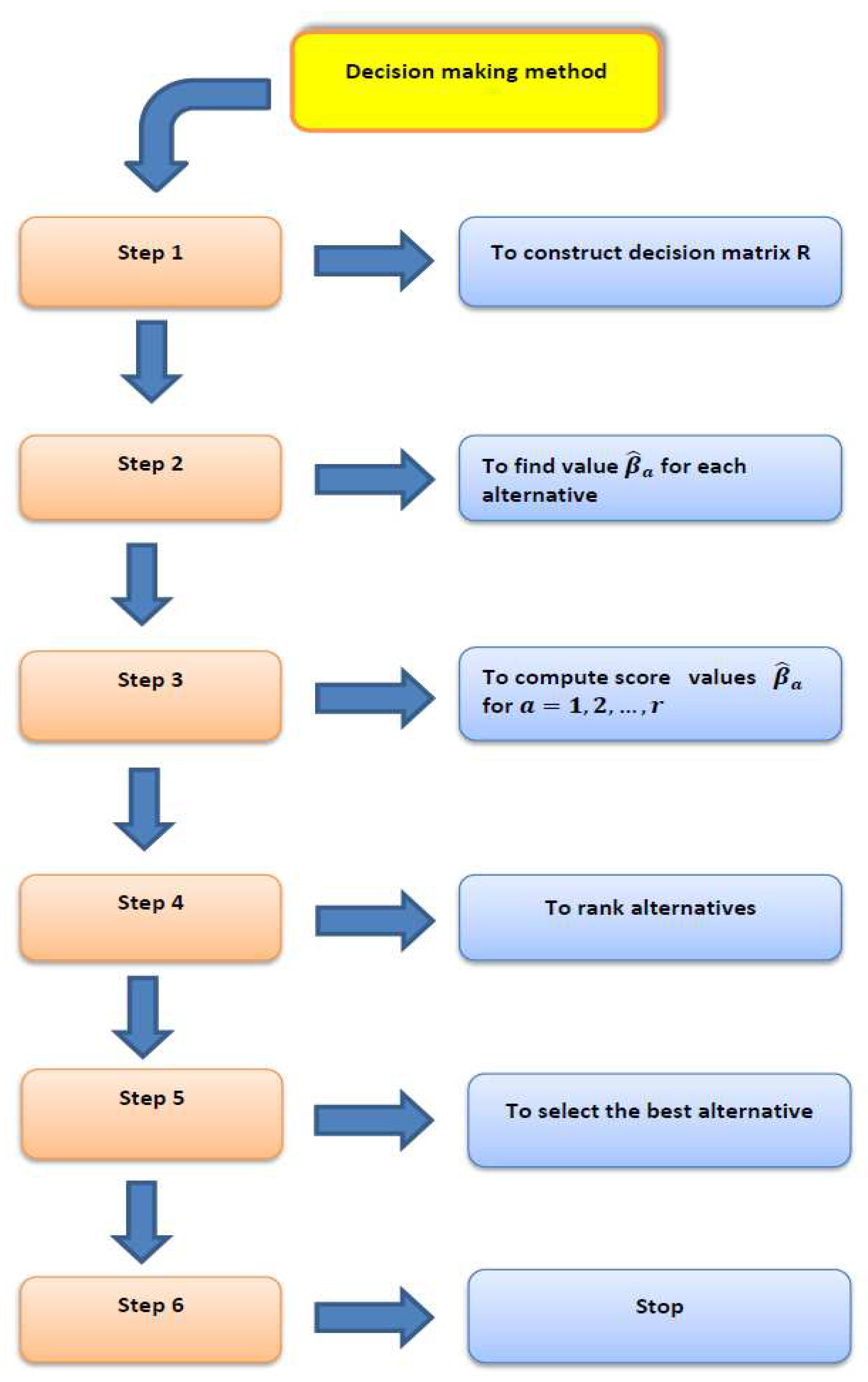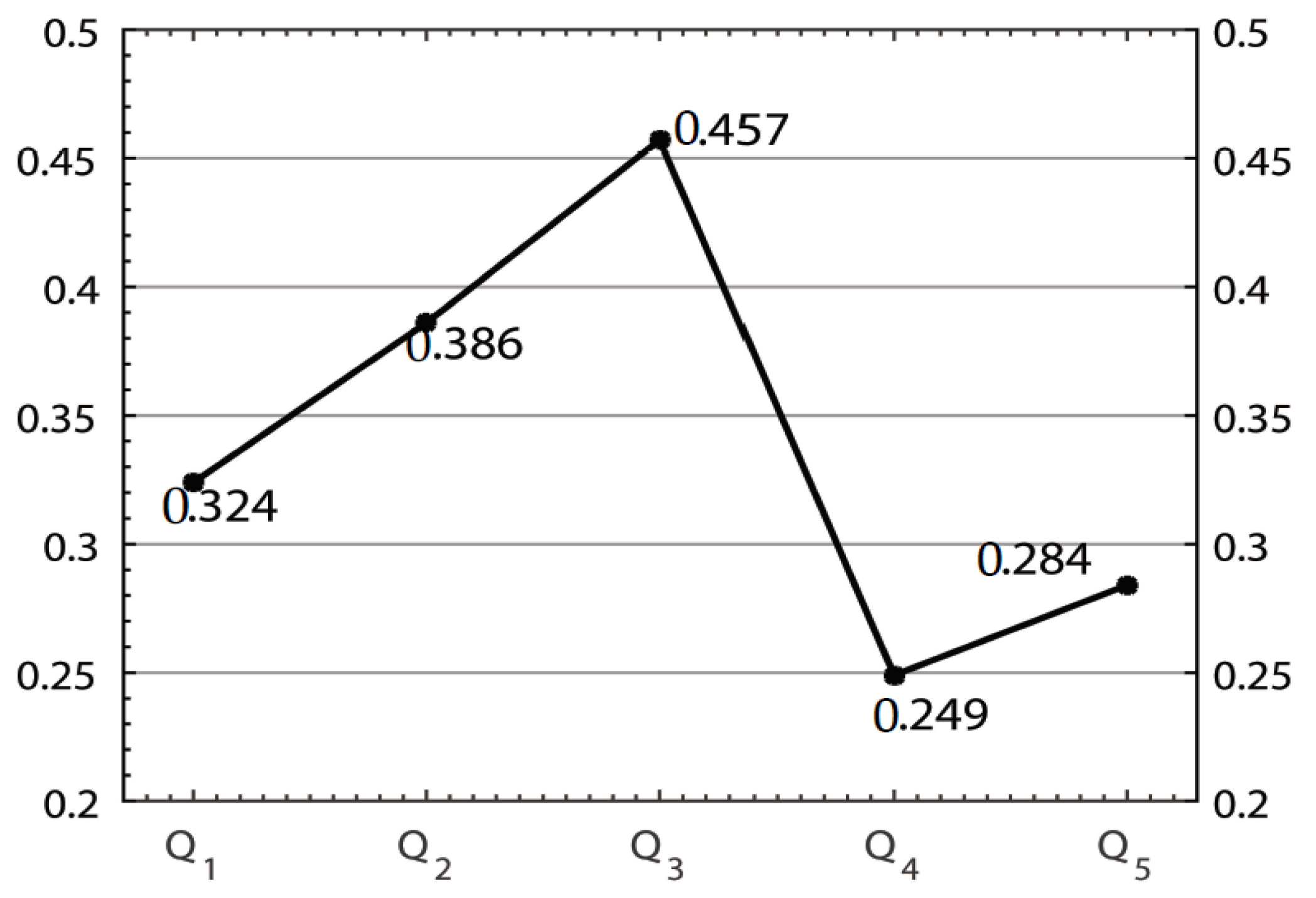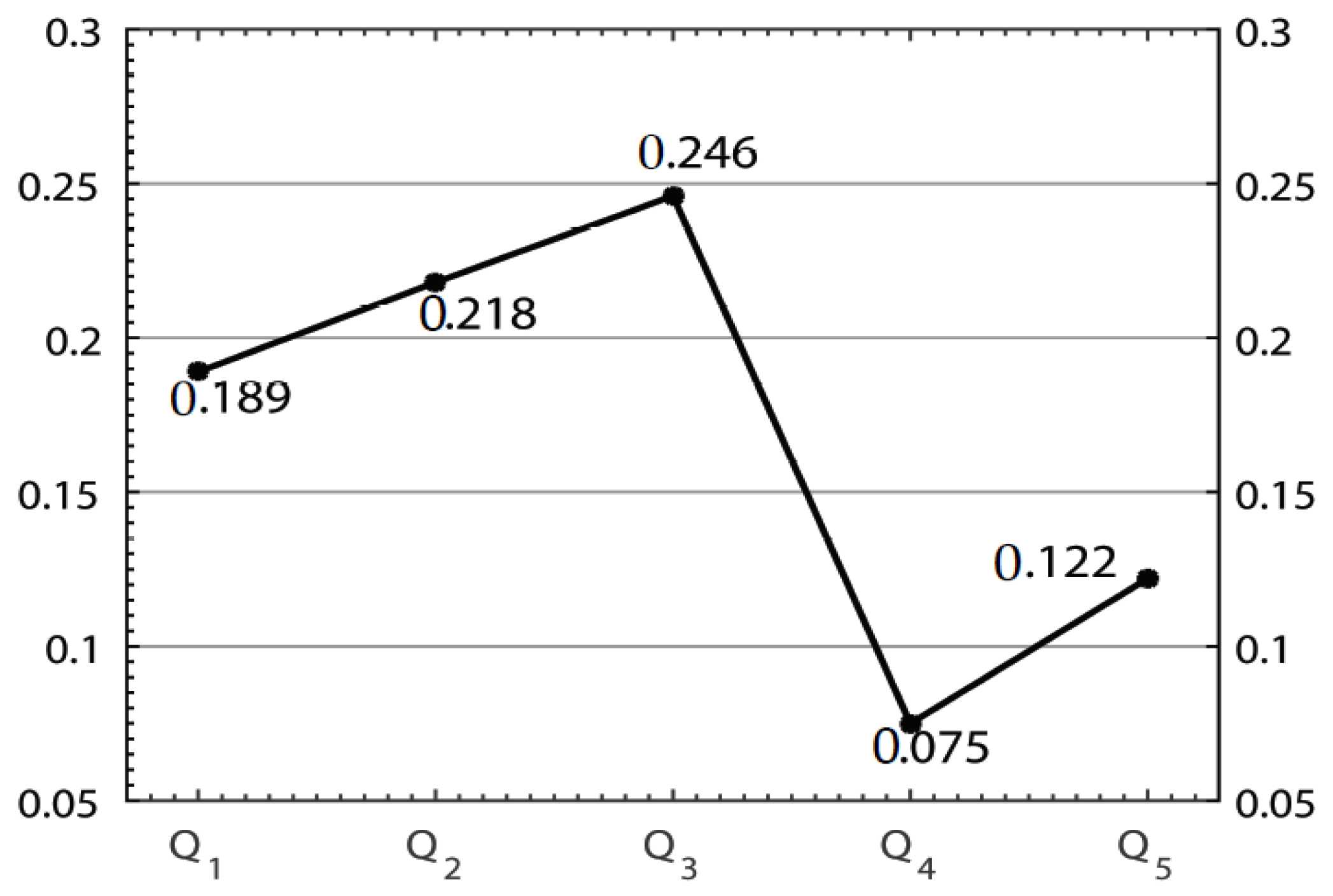Assessment of Enterprise Performance Based on Picture Fuzzy Hamacher Aggregation Operators
Abstract
1. Introduction
2. Preliminaries
2.1. Intuitionistic Fuzzy Sets
2.2. Picture Fuzzy Sets
3. Hamacher Operations (HOs) on the Picture Fuzzy Set
3.1. Hamacher Operations
3.2. Hamacher Operations(HOs) of Picture Fuzzy Set
- .
4. Model for MADM Using Picture Fuzzy Information
5. Numerical Example and Comparative Analysis
5.1. Numerical Example
- Financial performance
- Customer performance
- Internal processes of performance
- Staff performance
- Step 1. Decision matrix R is constructed by decision maker or expert under PF information as follows:
- Step 2. Let . By using the PFHWA operator of the overall performance values of enterprises, are obtained as follows:by a similar way, , , and are obtained as follows: , , , .
- Step 3. By using Equation (3) the score values of the overall PFNs are obtained as follows:By a similar way, , , , .
- Step 4. The ranking order in the performance of enterprises in accordance with the value of the score functions of the overall PFNs is as follows: .
- Step 5. is selected as the most desirable enterprises.
- Step 6. Stop.
- Step 1. Let us consider Table 1.
- Step 2. Let , using the PFHWG operator to evaluate the overall performance values of enterprisesby a similar way, , , and are obtained as , , , .
- Step 3. Calculate the values of the score functions of the overall picture fuzzy numbers as follows:, by a similar way, the other score values are obtained as follows , , , .
- Step 4. Rank all of the enterprises according to score values of the overall PFNs as .
- Step 5. Return is selected as the most desirable enterprise.
- Step 6. Stop.
5.2. Comparison Analysis
6. Conclusions
Author Contributions
Funding
Conflicts of Interest
References
- Mintzberg, H.; Ahlstrand, B.W.; Lampel, J. Strategy safari: A guided tour through the wilds of strategic management. Manag. Serv. 2009, 48, 152. [Google Scholar]
- Shrivastava, P. Advances in Strategic Management: Organizational Learning and Strategic Management; Emerald Group: Greenwicht, UK, 1997. [Google Scholar]
- Brockman, B.K.; Morgan, R.M. The Role of Existing Knowledge in New Product Innovativeness and Performance. Dec. Sci. 2003, 34, 385–419. [Google Scholar] [CrossRef]
- Baker, W.E.; Sinkula, J.M. The synergistic effect of market orientation and learning orientation on organizational performance. J. Acad. Mark. Sci. 1999, 27, 411–427. [Google Scholar] [CrossRef]
- Ussahawanitchakit, P. Impacts of organizational learning on innovation orientation and firm efficiency: An empirical assessment of accounting firms in Thailand. Int. J. Bus. Res. 2008, 8, 1–12. [Google Scholar]
- Merigó, J.M. Probabilities in the OWA operator. Expert Syst. Appl. 2012, 39, 11456–11467. [Google Scholar] [CrossRef]
- Merigó, J.M.; Casanovas, M.; Yang, J.B. Group decision making with expertons and uncertain generalized probabilistic weighted aggregation operators. Eur. J. Oper. Res. 2014, 235, 215–224. [Google Scholar] [CrossRef]
- Merigó, J.M. Decision-making under risk and uncertainty and its application in strategic management. J. Bus. Econ. Manag. 2015, 16, 1–24. [Google Scholar] [CrossRef]
- Merigó, J.M.; Gil-Lafuente, A.M.; Aluja, J.G. A new aggregation method for strategic decision making and its application in assignment theory. Afr. J. Bus. Manag. 2011, 5, 4033–4043. [Google Scholar]
- Li, D.F. Decision and Game Theory in Management with Intuitionistic Fuzzy Sets; Springer: Berlin, Germany, 2014; Volume 308, pp. 1–441. ISBN 978-3-642-40711-6. [Google Scholar]
- Zadeh, L.A. Fuzzy sets. Inform. Control 1965, 8, 338–353. [Google Scholar] [CrossRef]
- Adrian, C.; Abdullah, R.; Atan, R.; Jusoh, Y.Y. Conceptual Model Development of Big Data Analytics Implementation Assessment Effect on Decision-Making. Int. J. Interact. Multimed. Artif. Intell. 2017, 4, 28–33. [Google Scholar] [CrossRef]
- Idrus, A.; Mahmoud, M.A.; Ahmad, M.S.; Yahya, A.; Husen, H. A Solution Generator Algorithm for Decision Making-based Automated Negotiation in the Construction Domain. Int. J. Artif. Intell. Interact. Multimed. 2018, in press. [Google Scholar] [CrossRef]
- Morente-Molinera, J.A.; Kou, G.; González-Crespo, R.; Corchado, J.M.; Herrera-Viedma, E. Solving multi-criteria group decision making problems under environments with a high number of alternatives using fuzzy ontologies and multi-granular linguistic modelling methods. Knowl.-Based Syst. 2017, 137, 54–64. [Google Scholar] [CrossRef]
- Morente-Molinera, J.A.; Kou, G.; González-Crespo, R.; Corchado, J.M.; Herrera-Viedma, E. Managing multi-criteria group decision making environments with high number of alternatives using fuzzy ontologies. SOMET 2018, 303, 493–506. [Google Scholar]
- Atanassov, K.T. Intuitionistic Fuzzy Sets: Theory and Applications, Studies in Fuzziness and Soft Computing; Physica-Verlag: Heidelberg, Germany; New York, NY, USA, 1999; Volume 35. [Google Scholar]
- Chen, S.M.; Chiou, C.H. Multiattribute decision making based on interval-valued intuitionistic fuzzy sets, PSO techniques, and evidential reasoning methodology. IEEE Trans. Fuzzy Syst. 2015, 23, 1905–1916. [Google Scholar] [CrossRef]
- Du, Y.; Liu, P. Extended fuzzy VIKOR method with intuitionistic trapezoidal fuzzy numbers. Inf. Int. Interdiscip. J. 2011, 14, 2575–2583. [Google Scholar]
- Garg, H. A new generalized improved score function of interval-valued intuitionistic fuzzy sets and applications in expert systems. Appl. Soft Comput. 2016, 38, 988–999. [Google Scholar] [CrossRef]
- Kumar, K.; Garg, H. TOPSIS method based on the connection number of set pair analysis under interval-valued intuitionistic fuzzy set environment. Comput. Appl. Math. 2016. [Google Scholar] [CrossRef]
- Li, D.F. Closeness coefficient-based nonlinear programming method for interval-valued intuitionistic fuzzy multiattribute decision making with incomplete preference information. Appl. Soft Comput. 2011, 11, 3402–3418. [Google Scholar] [CrossRef]
- Lourenzutti, R.; Krohling, R.A. A study of TODIM in a intuitionistic fuzzy and random environment. Expert Syst. Appl. 2013, 40, 6459–6468. [Google Scholar] [CrossRef]
- Wan, S.P.; Li, D.F. Atanassovs intuitionistic fuzzy programming method for heterogeneous multiattribute group decision making with atanassovs intuitionistic fuzzy truth degrees. IEEE Trans. Fuzzy Syst. 2014, 22, 300–312. [Google Scholar] [CrossRef]
- Wan, S.P.; Li, D.F. Fuzzy mathematical programming approach to heterogeneous multiattribute decision-making with interval-valued intuitionistic fuzzy truth degrees. Inform. Sci. 2015, 325, 484–503. [Google Scholar] [CrossRef]
- Ye, J. Multicriteria fuzzy decision-making method based on a novel accuracy function under interval-valued intuitionistic fuzzy environment. Expert Syst. Appl. 2009, 36, 899–6902. [Google Scholar] [CrossRef]
- Zhang, L.; Zhan, J.; Xu, Z.S. Covering-based generalized IF rough sets with applications to multi-attribute decision-making. Inform. Sci. 2019, 478, 275–302. [Google Scholar] [CrossRef]
- Zhan, J.; Sun, B. Covering-based intuitionistic fuzzy rough sets and applications in multi-attribute decision-making. Artif. Intell. Rev. 2018. [Google Scholar] [CrossRef]
- Zhan, J.; Malik, H.M.; Akram, M. Novel decision-making algorithms based on intuitionistic fuzzy rough environment. Int. J. Mach. Learn. Cybern. 2018. [Google Scholar] [CrossRef]
- Yager, R.R. On ordered weighted avergaing aggregation operators in multi-criteria decision making. IEEE Trans. Syst. Man Cybern. 1988, 18, 183–190. [Google Scholar] [CrossRef]
- Yager, R.R.; Kacprzyk, J. The Ordered Weighted Averaging Operators: Theory and Applications; Kluwer: Boston, MA, USA, 1997. [Google Scholar]
- Xu, Z.S.; Yager, R.R. Some geometric aggregation operators-based on intuitionistic fuzzy sets. Int. J. Gen. Syst. 2006, 35, 417–433. [Google Scholar] [CrossRef]
- Xu, Z.S. Intuitionistic fuzzy aggregation operators. IEEE Trans. Fuzzy Syst. 2007, 15, 1179–1187. [Google Scholar]
- Hamacher, H. Uber logische verknunpfungenn unssharfer Aussagen undderen Zugenhorige Bewertungsfunktione. In Progress in Cybernatics and Systems Research; Trappl, K.R., Ed.; Hemisphere: Washington, DC, USA, 1978; Volume 3, pp. 276–288. [Google Scholar]
- Beliakov, G.; Pradera, A.; Calvo, T. Aggregation Functions: A Guide For Practitioner; Springer: Berlin/Heidelberg, Germany, 2007. [Google Scholar]
- Huang, J.Y. Intuitionistic fuzzy Hamacher aggregation operators and their application to multiple attribute decision making. J. Intell. Fuzzy Syst. 2014, 27, 505–513. [Google Scholar]
- Liu, P.D. Some Hamacher aggregation operators based on the interval-valued intuitionistic fuzzy numbers and their application to group decision making. IEEE Trans. Fuzzy Syst. 2014, 22, 83–97. [Google Scholar] [CrossRef]
- Xiao, S. Induced interval-valued intuitionistic fuzzy Hamacher ordered weighted geometric operator and their application to multiple attribute decision making. J. Intell. Fuzzy Syst. 2014, 27, 527–534. [Google Scholar]
- Li, W. Approaches to decision making with interval-valued intuitionistic fuzzy information and their application to enterprise financial performance assessment. J. Intell. Fuzzy Syst. 2014, 27, 1–8. [Google Scholar]
- He, Y.D.; Chen, H.Y.; He, Z.; Zhou, L.G. Multi-attribute decision making based on neutral averaging operators for intuitionistic fuzzy information. Appl. Soft Comput. 2015, 27, 64–76. [Google Scholar] [CrossRef]
- Jana, C.; Pal, M.; Wang, J.-Q. Bipolar fuzzy Dombi aggregation operators and its application in multiple attribute decision making process. J. Ambient Intell. Humaniz. Comput. 2018. [Google Scholar] [CrossRef]
- Jana, C.; Pal, M.; Karaaslan, F.; Wang, J.-Q. Trapezoidal neutrosophic aggregation operators and its application in multiple attribute decision -making process. Sci. Iran. E 2019, in press. [Google Scholar]
- Karaaslan, F. Correlation coefficients of single-valued neutrosophic refined soft sets and their applications in clustering analysis. Neural Comput. Appl. 2017, 28, 2781–2793. [Google Scholar] [CrossRef]
- Karaaslan, F. Possibility neutrosophic soft sets and PNS-decision making method. Appl. Soft Comput. 2017, 54, 403–414. [Google Scholar] [CrossRef]
- Khameneh, A.Z.; Kilicman, A. m-polar fuzzy soft weighted aggregation operators and their applications in group decision-making. Symmetry 2018, 10, 636. [Google Scholar] [CrossRef]
- Lu, M.; Wei, G.W.; Alsaadi, F.E.; Hayat, T.; Alsaedi, A. Hesitant pythagorean fuzzy hamacher aggregation operators and their application to multiple attribute decision making. J. Intell. Fuzzy Syst. 2017, 33, 1105–1117. [Google Scholar] [CrossRef]
- Tan, C.Q.; Yi, W.T.; Chen, X.H. Hesitant fuzzy Hamacher aggregation operators for multicriteria decision making. Appl. Soft Comput. 2015, 26, 325–349. [Google Scholar] [CrossRef]
- Wang, L.; Wang, Y.; Liu, X.D. Prioritized aggregation operators and correlated aggregation operators for hesitant 2-tuple linguistic variables. Symmetry 2018, 10, 39. [Google Scholar] [CrossRef]
- Wei, G.W. Some geometric aggregation functions and their application to dynamic multiple attribute decision making in intuitionistic fuzzy setting. Int. J. Uncertain. Fuzz. Knowl.-Based Syst. 2009, 17, 179–196. [Google Scholar] [CrossRef]
- Wei, G.W.; Lu, M. Dual hesitant pythagorean fuzzy Hamacher aggregation operators in multiple attribute decision making. Arch. Control Sci. 2017, 27, 365–395. [Google Scholar] [CrossRef]
- Wei, G.W.; Alsaadi, F.E.; Hayat, T.; Alsaedi, A. Bipolar fuzzy Hamacher aggregation operators in multiple attribute decision Making. Int. J. Fuzzy Syst. 2018, 20, 1–12. [Google Scholar] [CrossRef]
- Zhou, L.Y.; Zhao, X.F.; Wei, G.W. Hesitant fuzzy Hamacher aggregation operators and their application to multiple attribute decision making. J. Intell. Fuzzy Syst. 2014, 26, 2689–2699. [Google Scholar]
- Cuong, B.C. Picture Fuzzy Sets-First Results, Part 1, Seminar Neuro-Fuzzy Systemswith Applications; Tech. Rep.; Instiute of Mathematics: Hanoi, Vietnam, 2013. [Google Scholar]
- Cuong, B.C. Picture Fuzzy Sets-First Results, Part 2, Seminar Neuro-Fuzzy Systemswith Applications; Tech. Rep.; Instiute of Mathematics: Hanoi, Vietnam, 2013. [Google Scholar]
- Cuong, B.C. Picture fuzzy sets. J. Comput. Sci. Cybern. 2014, 30, 409–420. [Google Scholar]
- Singh, P. Correlation coefficients for picture fuzzy sets. J. Intell. Fuzzy Syst. 2014, 27, 2857–2868. [Google Scholar]
- Jana, C.; Senapati, T.; Pal, M.; Yager, R.R. Picture fuzzy Dombi aggregation operators: Application to MADM process. Appl. Soft Comput. 2019, 74, 99–109. [Google Scholar] [CrossRef]
- Son, L. DPFCM: A novel distributed picture fuzzy clustering method on picture fuzzy sets. Expert Syst. Appl. 2015, 2, 51–66. [Google Scholar] [CrossRef]
- Thong, P.H.; Son, L.H. A new approach to multi-variables fuzzy forecasting using picture fuzzy clustering and picture fuzzy rules interpolation method. In Proceedings of the 6th International Conference on Knowledge and Systems Engineering, Hanoi, Vietnam, 9–11 October 2014; pp. 679–690. [Google Scholar]
- Thong, N.T. HIFCF An effective hybrid model between picture fuzzy clustering and intuitionistic fuzzy recommender systems for medical diagnosis. Expert Syst. Appl. 2015, 42, 3682–3701. [Google Scholar] [CrossRef]
- Son, L.H. Generalized picture distance measure and applications to picture fuzzy clustering. Appl. Soft Comput. 2016, 46, 284–295. [Google Scholar] [CrossRef]
- Wei, G.W. Picture fuzzy cross-entropy for multiple attribute decision making problems. J. Bus. Econ. Manag. 2016, 17, 491–502. [Google Scholar] [CrossRef]
- Wei, G.W. Picture 2-tuple linguistic Bonferroni mean operators and their application to multiple attribute decision making. Int. J. Fuzzy Syst. 2017, 19, 997–1010. [Google Scholar] [CrossRef]
- Nie, R.X.; Wang, J.Q.; Li, L. A shareholder voting method for proxy advisory firm selection based on 2-tuple linguistic picture preference relation. Appl. Soft Comput. 2017, 60, 520–539. [Google Scholar] [CrossRef]
- Wang, L.; Zhang, H.Y.; Wang, J.Q.; Li, L. Picture fuzzy normalized projection-based VIKOR method for the risk evaluation of construction project. J. Intell. Fuzzy Syst. 2018, 64, 216–226. [Google Scholar] [CrossRef]
- Zhang, X.Y.; Wang, J.Q.; Hu, J.H. On novel operational laws and aggregation operators of picture 2-tuple linguistic information for MCDM problems. Int. J. Fuzzy Syst. 2017. [Google Scholar] [CrossRef]
- Wei, G.W. Picture fuzzy Hamacher aggregation operators and their application to multiple attribute decision making. Fundam. Inform. 2018, 157, 271–320. [Google Scholar] [CrossRef]
- Chen, S.M.; Tan, J.M. Handling multicriteria fuzzy decision-making problems based on vague set theory. Fuzzy Sets Syst. 1994, 67, 163–172. [Google Scholar] [CrossRef]
- Deschrijver, G.; Cornelis, C.; Kerre, E.E. On the representation of intuitionistic fuzzy t-norms and t-conorms. IEEE Trans. Fuzzy Syst. 2004, 12, 45–61. [Google Scholar] [CrossRef]
- Roychowdhury, S.; Wang, B.H. On generalized Hamacher families of triangular operators. Int. J. Approx. Reason. 1998, 19, 419–439. [Google Scholar] [CrossRef]
- Deschrijver, G.; Kerre, E.E. Ageneralization of operators on intuitionistic fuzzy sets using triangular norms and conorms. Notes Intuitionistic Fuzzy Sets 2002, 8, 19–27. [Google Scholar]
- Wei, G.W. Picture fuzzy aggregation operators and their application to multiple attribute decision making. J. Intell. Fuzzy Syst. 2017, 33, 713–724. [Google Scholar] [CrossRef]



| (0.56, 0.34, 0.10) | (0.90, 0.06, 0.04) | (0.40, 0.33, 0.19) | (0.09, 0.79, 0.03) | |
| (0.70, 0.10, 0.09) | (0.10, 0.66, 0.20) | (0.06, 0.81, 0.12) | (0.72, 0.14, 0.09) | |
| (0.88, 0.09, 0.03) | (0.08, 0.10, 0.06) | (0.05, 0.83, 0.09) | (0.65, 0.25, 0.07) | |
| (0.80, 0.07, 0.04) | (0.70, 0.15, 0.11) | (0.03, 0.88, 0.05) | (0.07, 0.82, 0.05) | |
| (0.85, 0.06, 0.03) | (0.64, 0.07, 0.22) | (0.06, 0.88, 0.05) | (0.13, 0.77, 0.09) |
| () | ||||
|---|---|---|---|---|
| (0.4431, 0.3969, 0.0683) | (0.2555, 0.5656, 0.0957) | (0.5825, 0.2914, 0.0515) | (0.1766, 0.6381, 0.0984) | |
| (0.5412, 0.2588, 0.1063) | (0.2789, 0.4972, 0.1106) | (0.6040, 0.1859, 0.1045) | (0.1462, 0.6094, 0.1113) | |
| (0.5801, 0.2665, 0.0627) | (0.2595, 0.4914, 0.0672) | (0.6908, 0.1929, 0.0575) | (0.1236, 0.6196, 0.0675) | |
| (0.3815, 0.4320, 0.0517) | (0.1113, 0.7415, 0.0542) | (0.5175, 0.2298, 0.0502) | (0.0621, 0.8022, 0.0544) | |
| (0.4264, 0.3785, 0.0662) | (0.1760, 0.7117, 0.0806) | (0.5816, 0.1779, 0.0569) | (0.1181, 0.7801, 0.0824) |
| () | ||||
|---|---|---|---|---|
| 0.3748 | 0.1598 | 0.7655 | 0.5391 | |
| 0.4349 | 0.1683 | 0.7498 | 0.5175 | |
| 0.5174 | 0.1923 | 0.8167 | 0.5281 | |
| 0.3298 | 0.0571 | 0.7337 | 0.5039 | |
| 0.3602 | 0.0954 | 0.7624 | 0.5179 |
© 2019 by the authors. Licensee MDPI, Basel, Switzerland. This article is an open access article distributed under the terms and conditions of the Creative Commons Attribution (CC BY) license (http://creativecommons.org/licenses/by/4.0/).
Share and Cite
Jana, C.; Pal, M. Assessment of Enterprise Performance Based on Picture Fuzzy Hamacher Aggregation Operators. Symmetry 2019, 11, 75. https://doi.org/10.3390/sym11010075
Jana C, Pal M. Assessment of Enterprise Performance Based on Picture Fuzzy Hamacher Aggregation Operators. Symmetry. 2019; 11(1):75. https://doi.org/10.3390/sym11010075
Chicago/Turabian StyleJana, Chiranjibe, and Madhumangal Pal. 2019. "Assessment of Enterprise Performance Based on Picture Fuzzy Hamacher Aggregation Operators" Symmetry 11, no. 1: 75. https://doi.org/10.3390/sym11010075
APA StyleJana, C., & Pal, M. (2019). Assessment of Enterprise Performance Based on Picture Fuzzy Hamacher Aggregation Operators. Symmetry, 11(1), 75. https://doi.org/10.3390/sym11010075





